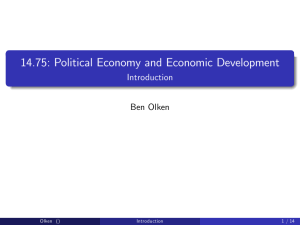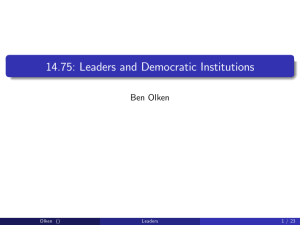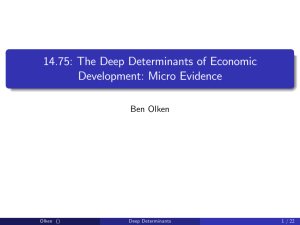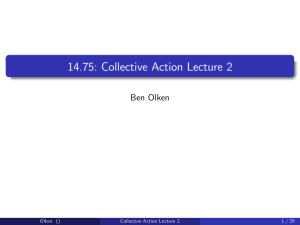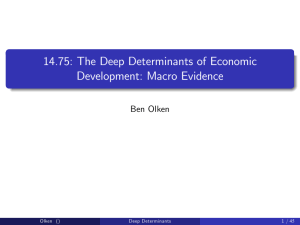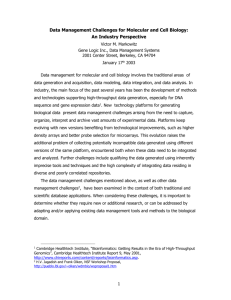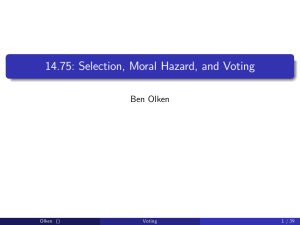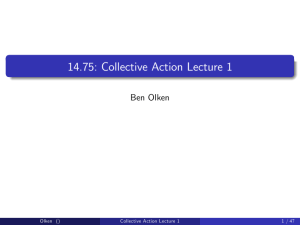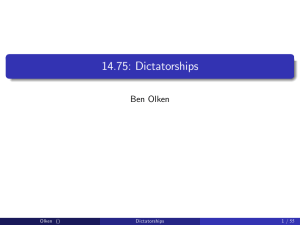Confiict Lecture 14.7 : 5
advertisement
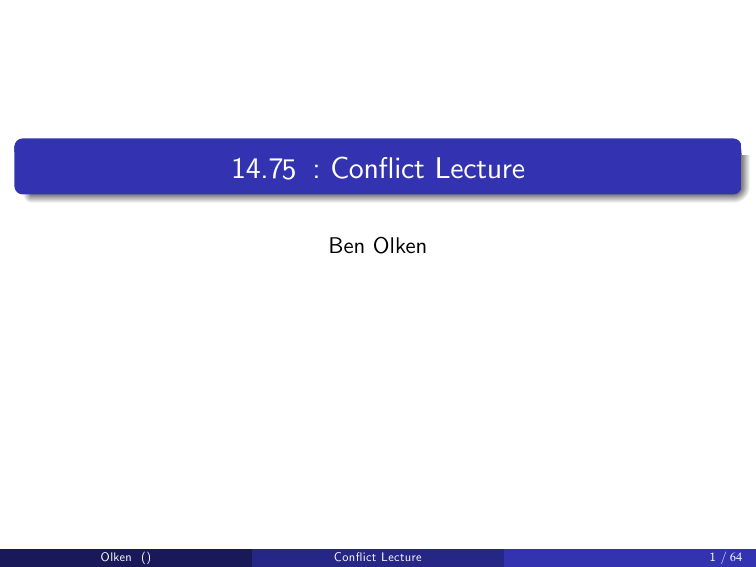
14.75 : Confiict Lecture Ben Olken Developm Olken () Confiict Lecture 1 / 64 Outline Theory The puzzle: why do wars happen Some answers: Bias, commitment problems Empirics: Resources and confiict Leaders and confiict Cost of confiict Olken () Confiict Lecture 2 / 64 The puzzle The key puzzle in confiict is why wars happen at all Why is this a puzzle? Olken () Confiict Lecture 3 / 64 The puzzle Here is a very simple model of wars. Based on Jackson and Morelli model — this is a simpler version, we’ll do the full version later in this lecture. Two countries: i and j. Let wi denote wealth of country i Let’s suppose that wi > wj . Suppose that country i can decide whether or not to start a war with country j. ∂p i If war exists, i wins with probability pi (wi , wj ), with ∂w ≥ 0 and i ∂p i ∂wj ≤0 pi is called the Contest Success Function For now, let’s assume a very simple contest success function pi = wi wi + wj What is the interpretation of this function? Olken () Confiict Lecture 4 / 64 Costs and benefits of war Costs and benefits: War costs C . If i wins, it gains fraction G > 0 of other country’s wealth. So if i wins i ends up with wi − C + Gwj and if i loses i ends up with wi − C Olken () Confiict Lecture 5 / 64 Conditions for war When will i start a war? i will start a war if expected gains are greater than expected losses So wi Gwj − C wi + wj wi Gwj wi + wj > 0 > C So gains from war are increasing in G , decreasing in C . If G is high enough or C is low enough, we can get war in equilibrium. In this particular model, they are also decreasing in inequality (i.e. they wi wj are increasing in w i + w j . This is maximized at wi = wj . But this is less general). So far, no puzzle. Olken () Confiict Lecture 6 / 64 The puzzle What is the puzzle? Suppose everyone knows that the parameters are such that wi Gwj > C wi + wj so i will prefer to attack j. What will j do? j will prefer to just pay i to avoid the war In particular, suppose j offers to pay i wi Gwj − C + ε wi + wj in exchange for a peace treaty. i will clearly accept this since this is greater (by ε) than gain from war Olken () Confiict Lecture 7 / 64 Peace treaties Will this be better for j? Under war, j will end up with wj 1− wi G wi + wj since it will lose Gwj with probability w i w+iw j . It will prefer to make the payment of wi Gwj − C + ε wi + wj if wi wi Gwj − C + ε > wj 1 − G wi + wj wi + wj wi wi − Gwj − C + ε > wj G wi + wj wi + wj C −ε > 0 So as long as ε is positive but not too large relative to C , j will prefer to make this payment, i will accept it, and there will be peace. wj − Olken () Confiict Lecture 8 / 64 The puzzle This is the puzzle about war: The costs of war are just social losses C . Everyone loses C . The gains from war are (usually) a transfer. So it’s Pareto improving to just make the expected value of the transfer anyway and avoid the social losses C . This is one view of diplomacy, peace treaties, etc. But this argument says that wars should never happen. Yet they do. Why? One answer is that wars are mistakes Grim trigger strategy with mutually assured destruction, but with noise you can get wars But why might there be rational reasons for war? What answers does Fearon give? Olken () Confiict Lecture 9 / 64 Reasons for wars Some reasons people might choose wars: Irrationalities Divergent interests between leaders and citizens "Rational reasons" Private information about relative capabilities and problems (or misincentives) to communicate that information Commitment problems Indivisibilities There are models of each of these — I will focus on a model of leaders, transfers, and commitment Olken () Confiict Lecture 10 / 64 A model of leaders, transfers, commitment, and war Jackson and Morelli (2007): "Political " Bias and War"" This is now the full model in Jackson and Morelli - it’s slightly different than the version I started with. Two countries: i and j. Let wi denote wealth of country i Either country can choose to start a war If war exists, i wins with probability pi (wi , wj ), with ∂∂wpii ≥ 0 and ∂p i ∂wj ≤ 0. This is the Contest Success Function. Costs and benefits: War costs fraction C > 0 of each country’s wealth. This cost is now proportional to wealth (whereas in the earlier model it was a fixed cost). If a country wins, it gains G > 0 of other country’s wealth. So if i wins i ends up with wi (1 − C ) + Gwj and if i loses i ends up with wi ( 1 − C − G ) Olken () Confiict Lecture 11 / 64 Leaders Leaders: Leader i controls fraction ai of country’s wealth wi If there is a war and i wins, leader i obtains fraction ai; of Gwj a; Denote Bi = ai i to be the "political bias" of country. What is this? So leader will choose war if ai; pi Gwj > [C + (1 − pi ) G ] ai wi or equivalently Bi pi Gwj > [C + (1 − pi ) G ] wi So range of parameters where i prefers war: Increasing in B and G , and decreasing in C C and not on levels Depends only on the ratio of G Depends only on B and not on values of a and a; Olken () Confiict Lecture 12 / 64 Analysis Proposition: If probability of winning is proportional to relative wealth w (p = w j +jw i ), then with no bias there will be no war To see this, recall that j prefers war if Substituting yields: Bj pj Gwi > C + 1 − pj G wj wj wi Gwi > C + G wj wj + wi wj + wi and rearranging yields Bj Bj − 1 Gwi >C wi + wj So if there is no bias (Bj = 1), then j will never prefer war. Intuition: as wi increases, gains from war increase but probability of winning decreases, and with proportional probability of winning these effects exactly cancel Not general: with other probability functions, one country can prefer Confiict Lecture 13 / 64 warOlken () Analysis Case 1: No transfers Recall country i wants war if Bi pi Gwj > [C + (1 − pi ) G ] wi and country j wants war if Bj pj Gwi > [C + (1 − pj ) G ] wj Proposition 1: 1 2 3 If Bi = Bj = 1, then at most one country wants to go to war C , if B and B are both suffi ciently large, then both countries Fixing G i j want to go to war C is suffi ciently large, then neither country wants Fixing Bi and Bj , if G to go to war Olken () Confiict Lecture 14 / 64 Proofs Proof of part 1 If Bi = Bj = 1, then the conditions for war are: i: j: pi Gwj > [C + (1 − pi ) G ] wi pj Gwi > [C + (1 − pj ) G ] wj Suppose wlog that i wants war, so Want to show pi Gwj > [C + (1 − pi ) G ] wi pj Gwi (1 − pi ) Gwi (1 − pi ) Gwi − Cwj (1 − pi ) Gwi − Cwi + Cwi − Cwj [C + (1 − pi ) G ] wi − Cwi − Cwj −Cwi − Cwj Olken () < < < < < < Confiict Lecture [C + (1 − pj ) G ] wj Cwj + pi Gwj pi Gwj pi Gwj pi Gwj pi Gwj − [C + (1 − pi ) G ] wi 15 / 64 Proofs −Cwi − Cwj < pi Gwj − [C + (1 − pi ) G ] wi We know that > [C + (1 − pi ) G ] wi 0 < pi Gwj − [C + (1 − pi ) G ] wi pi Gwj Since 0 < pi Gwj − [C + (1 − pi ) G ] wi and we know that −Cwi − Cwj < 0 −Cwi − Cwj < pi Gwj − [C + (1 − pi ) G ] wi which is what we were trying to show. Olken () Confiict Lecture 16 / 64 Proofs Proof of part 2: Fixing GC , if Bi and Bj are both suffi ciently large, then both countries want to go to war The conditions for war are: i: j: Bi pi Gwj > [C + (1 − pi ) G ] wi Bj pj Gwi > [C + (1 − pj ) G ] wj It is easy to see that sending Bk → ∞, both sides will want war Olken () Confiict Lecture 17 / 64 Proofs Proof of part 3: Fixing Bi and Bj , if neither country wants to go to war C G is suffi ciently large, then The conditions for war are: i: j: Bi pi Gwj > [C + (1 − pi ) G ] wi Bj pj Gwi > [C + (1 − pj ) G ] wj We can rewrite as i: j: C + (1 − pi ) wi G C Bj pj wi > + (1 − pj ) wj G Bi pi wj > So once again, clearly sending What is the intuition here? Olken () C G → ∞, neither side wants war Confiict Lecture 18 / 64 Analysis Case 2: Transfers with commitment Idea of commitment In domestic context, commitment can be through changes in constitution, ownership of assets In international context, commitment can be through international institutions Assumption about transfers: the bias for transfer is the same as the bias for war — the leader of losing country pays ai and leader of winning country gets ai; Transfers will avoid a war if wi C ( 1 − p j ) ( Bi Bj − 1 ) p j 1 + Bj −1 > > G wj 1 + B wi j wj LHS states that country j wants to go to war with i in absence of transfer (same equation as before) RHS states that country i willing to make a transfer high enough that would induce j to prefer peace Olken () Confiict Lecture 19 / 64 Analysis Case 2: Transfers with commitment Derivation of RHS: j prefers peace if (1 − C − G ) aj wj + pj G aj wj + aj; wi ≤ aj wj + aj; t which simplifies to pj G wj + Bj wi ≤ (C + G ) wj + Bj t Likewise i prefers peace if 1 − pj G wi + Bi wj ≤ (C + G ) wi − t Combining these yields the RHS of the previous expression Olken () Confiict Lecture 20 / 64 Analysis Case 2: Transfers with commitment Recall transfers will avoid a war if pj 1 + Bj wi wj −1 > C ( 1 − p j ) ( Bi Bj − 1 ) > G 1 + B wi j wj Propositions 2 and 3: With no bias, there is no war. So, in this model, the ability to make transfers prevents war (as in the simpler model we started with) C where transfers can avoid j wanting to More generally, the range of G launch an attack is increasing when 1 2 3 Olken () Bi decreases, since i is less likely to want to go to war, and therefore willing to pay more to avoid it pj increases, since it makes j more likely to want war and i more willing to pay to avoid it wi w j increases (holding p fixed), for same reasons as (2) Confiict Lecture 21 / 64 Analysis Case 2: Transfers with commitment Recall transfers will avoid a war if pj 1 + Bj wi wj −1 > C ( 1 − p j ) ( Bi Bj − 1 ) > G 1 + B wi j wj So: With bias, transfers can prevent war if the bias Bi of the target country i is not too great Olken () Confiict Lecture 22 / 64 Analysis Case 3: Transfers with no commitment Now, transfers need to be self-enforcing, i.e., after transfer takes place, aggressor needs to prefer no war to war. Why is this? Transfers have three effects on ex-post probability of war, which operate in different directions: Make target poorer and less appealing (decrease war) Make challenger richer, with more to lose (decrease war) Increase the probability that challenger will a subsequent war (increase war) Properties of this equilibrium: Cases where transfers can avoid war with no commitment are a strict subset of cases where it avoids war with commitment It is possible that small transfers avoid a war whereas large transfers do not (if transfer is too large, it affects the probability of victory too much and ex-post the aggressor will want to invade) Olken () Confiict Lecture 23 / 64 Analysis Conclusions w If probability of winning is proportional to relative wealth (p = w j +jw i ), then with no bias there will be no war, even without commitment With other probability functions, if you lose either unbiasedness or commitment, you can get war Endogenous bias With no transfers, everyone prefers unbiased leader, because the leader maximizes the same thing as the population With transfers, citizens might prefer a biased leader if it induces more transfers from the other side Any examples like this? E.g. you might elect Ronald Reagan to scare the Soviet Union, even if you think he’s more prone to war than you’d like him to be Olken () Confiict Lecture 24 / 64 Empirical work on confiict Here are some questions we’ll examine: Where does confiict take place? Resources For civil wars, resources can have multiple impacts More to grab if resources go up. But also opportunity cost of fighting increases. Examples: changes in prices, changes in foreign aid Leaders If biased leaders can cause confiict, does changing the leader change confiict? The economic costs of war Costs of child soldiers Economic costs in the short run Economic costs in the long run Olken () Confiict Lecture 25 / 64 Trends in confiict Image removed due to copyright restrictions. Please see: Figure 1. Number and Percentage of Countries with Ongoing Civil Wars by Year from 1945-1999 from Fearson, James D., and David D. Laitin. "Ethnicity, Insurgency, and Civil War." 7KH$PHULFDQ3ROLWLFDO6FLHQFH5HYLHZ 97 no. 1 (2003): 75-90. Olken () Confiict Lecture 26 / 64 Patterns of where confiict occurs Image removed due to copyright restrictions. Please see: Table 1. Logit Analyses of Determinants of Civil War Onset, 1956-99 from Fearson, James D., and David D. Laitin. "Ethnicity, Insurgency, and Civil War." 7KH$PHULFDQ3ROLWLFDO6FLHQFH5HYLHZ 97 no. 1 (2003): 75-90. Olken () Confiict Lecture 27 / 64 Resources and civil war Note we can start by using the same models as before, but think of countries as groups within the countries (i.e., i = incumbent government, j = rebels) How did resources (w ) enter into the model above? Affected the amount you had to gain from winning Affected the probability you won Affected the costs of fighting (since the cost was proportional to wealth) What would be an effect of an increase in wi (governemnt wealth) on rebel’s desire to start a civil war? Bigger gains from winning Increases costs to government of a war (e.g. more valuable factories that can get blown up; higher wages needed to pay soldiers) But lower probability of winning Net effect ambiguous Olken () Confiict Lecture 28 / 64 What else might matter For civil war, for the rebels (j) the costs of fighting C may be largely about opportunity cost. Why? Soldiers have to come from somewhere. So you have a choice: Should you be a farmer and grow coffee (or whatever). Or should you go join a rebel army and try to overthrow the government? Increasing economic opportunities for rebels (e.g. increasing the returns to growing coffee) make being a soldiers less attractive, holding everything else constant Olken () Confiict Lecture 29 / 64 Testing the role of resources " Miguel et al (2004): "Economic Shocks and Civil Con‡ict: An Instrumental Variables Approach"" Suppose you just regressed probability of civil war on gdp per capita (Like Fearon and Laitin) Would this be a good idea? Why or why not? Problem is that civil war is probably very bad for economic growth Idea of this paper: We want to look for "exogenous" shocks to income and see if they affect confiict They propose to look at the impact of rainfall, which in very poor countries affects incomes Olken () Confiict Lecture 30 / 64 Rainfall, Growth, and Confiict What’s the regression they’d want to estimate? What’s the first stage? What’s the reduced form? What’s the IV? What’s the exclusion restriction? Does this seem plausible? What might you be concerned about? Thinking about the various ways that incomes could affect confiict, which ones would this affect? Olken () Confiict Lecture 31 / 64 Specifications First stage: git = a + X ; b + c1 ΔRit + c2 ΔRit −1 + αt + εit Reduced form: confiictit = a + X ; b + c1 ΔRit + c2 ΔRit −1 + αt + εit IV: confiictit = a + X ; b + git + αt + εit where we instrument for git using the predicted relationship from the first stage Olken () Confiict Lecture 32 / 64 Results First stage - Reduced form - IV Images removed due to copyright restrictions. See: Miguel, Edward, Shanker Satyanath, et al. "Economic Shocks and Civil Conflict: An Instrumental Variables Approach." -RXUQDORI3ROLWLFDO(FRQRP\ 112, no. 4 (2004): 725-53. Table 2 Rainfall and Economic Growth (First Stage) Dependent Variable: Economic Growth Rate, W Table 3 Rainfall and Civil Conflict (Reducted-Form) Table Economic Growth and Civil Conflict. Olken () Confiict Lecture 33 / 64 Testing con‡ict theories using within-country data " Dube and Vargas (2010): "Commodity Price Shocks and Civil Con‡ict: Evidence from Columbia"" Common theme of confiict theory: if you increase a country’s wealth, you increase the probability a country will be attacked In the civil war context there are two countervailing forces: Increasing income increases the return from winning a confiict (↑ fighting) But increasing income also raises the return to working instead of fighting to expropriate resources (↓ fighting) So net effect is ambiguous, and depends on the type of shock and the factor intensity of the shock Increase return to capital-intensive sector might increase war if it increases returns to owning capital more than wages Increase return to labor-intensive sector might decrease war if it increases return to labor more than to expropriating resources Dube and Vargas test these ideas using within-country data from Colombia Olken () Confiict Lecture 34 / 64 Empirical idea Empirical Strategy: Shocks to international oil price are shocks to expropriable sector Shocks to international coffee price are shocks to labor-intensive sector Different parts of the country specialize in oil vs. coffee, so these shocks affect each municipality differently Predictions? Plausible? Concerns? Data Municipal level data on all confiict incidents from 1988-2005 — 21,000 incidents in total — in 966 municipalities Classify municipality as coffee producing based on 1997 "National Coffee Survey" Classify municipality as oil producing if they contain oil reserves or oil pipelines Olken () Confiict Lecture 35 / 64 Specification Estimate yit = αj + βt + (CoffeeIntj × CoffeePricet ) δ + (Oilj × Oilpricet ) λ + Popjt φ + εjt where they instrument for (CoffeeIntj × CoffeePricet ) using CoffeeIntj times the quantity of foreign coffee exports in time t Can also include department (state) specific time trends Outcome variables: Confiict Wages Government spending Olken () Confiict Lecture 36 / 64 Results Confiict Courtesy of Oeindrila Dube, Juan F. Vargas, and the President and Fellows of Harvard College. Used with permission. Olken () Confiict Lecture 37 / 64 Results Wages Table VI: The Effect of the Coffee and Oil Shocks on Wages, 1996-2004 Subsample: Coffee int x log coffee price Oil production x log oil price Oil pipe length x log oil price Observations (1) All workers 0.096 (0.026)*** 1.100 (1.097) -0.136 (0.088) 52,773 (2) (3) Agricultural Non-agricultural workers workers 0.111 (0.029)*** 0.176 (1.880) -0.149 (0.130) 34,768 -0.099 (1.040) 1.818 (9.748) -0.179 (1.068) 18,005 Courtesy of Oeindrila Dube, Juan F. Vargas, and the President and Fellows of Harvard College. Used with permission. Olken () Confiict Lecture 38 / 64 Results Other agricultural products Courtesy of Oeindrila Dube, Juan F. Vargas, and the President and Fellows of Harvard College. Used with permission. Olken () Confiict Lecture 39 / 64 One more example What about the impact of foreign aid? Suppose the US government increases its supply of food aid to a country. What would you expect the impact on confiict to be? How does the model help you think about this? Suppose you regressed confiict on aid. Would this be a good idea? Why or why not? Olken () Confiict Lecture 40 / 64 Food aid and con‡ict Nunn and Qian (2012): "Aiding " Con‡ict: The Impact of U.S. Food Aid on Civil War"" Empirical idea: The US food aid system is part of a system to keep farm prices high in the US So when there is a good wheat crop in the US, the government buys extra wheat and gives it out as aid Tends to give it out to the same countries So... They look at whether good US wheat harvests lead to more or less confiict in countries that tend to receive aid Idea is that this is occuring through the aid channel Thoughts? Olken () Confiict Lecture 41 / 64 Results Wheat aid vs. wheat production Images removed due to copyright restrictions. See: Nunn, Nathan, and Nancy Qian. "Aiding Conflict: The Impact of U.S. Food Aid on Civil War." NBER Working Paper No. 17794 (2012). Figure 5: Average U.S. Wheat Aid and Lagged U.S. Wheat Production Figure 7: Average Civil Conflict Incidence and Lagged U.S. Wheat Production Table 2: The Effect of Food Aid on Conflict Table 7: The Effect of Food Aid on Small- and Large-Scale Conflicts What is this? Olken () Confiict Lecture 42 / 64 Do Leaders Matter? " Jones and Olken (2009): "Hit or Miss: The e¤ect of assassinations on institutions and " war" Empirical question: do leaders affect war? Previous theories suggests that they might Specific prediction: If you are engaged in a war, this may be because you have a biased leader So if you change the leader, that increases the probability war ends Empirical strategy: (we’ve seen this before) Examine assassinations of national leaders Use failed assassination attempts as controls, and examine the difference between successful and failed attempts Outcomes: political regime change and change in confiict Olken () Confiict Lecture 43 / 64 Results Confiict Table 7—Assassinations and Conflict: Change One Year After Attempt Gleditsch-COW dataset 1875–2002 (1) Gleditsch-COW dataset 1946–2002 (2) PRIO/Uppsala dataset 1946–2002 (3) Parm. p-value Nonparm. p-value −0.072 (0.068) 0.29 0.57 0.041 (0.093) 0.66 0.83 0.162 (0.071) 0.02** 0.03** Observations Data source 223 Gleditsch 116 Gleditsch 116 PRIO Panel B: Split by war status in year before attempt Success × intense war −0.255 (0.144) −0.103 (0.257) −0.110 (0.294) 0.334 (0.163) 0.070 (0.057) 0.71 0.69 Panel A: Average effects Success Success × moderate war Success × not at war Intense war—parm. p-value Intense war—nonparm. p-value Moderate war—parm. p-value Moderate war—nonparm. p-value Not at war—parm. p-value Not at war—nonparm. p-value Observations Data source Olken () −0.024 (0.068) 0.08* 0.13 0.020 (0.086) 0.69 1.00 N/A N/A N/A N/A 0.05** 0.13 0.73 0.62 0.82 0.71 0.22 0.21 222 Gleditsch 116 Gleditsch 116 PRIO Confiict Lecture 44 / 64 The costs of confiict Costs of confiict are many Examples? Lives lost Destruction of capital stock (bombed factories, etc) Lack of investment Lost human capital aquisition Evidence we’ll examine: Human capital costs: Child soldiering in Vietnam Economic costs over the short run: Spain Economic costs of large wars long run: World War II, Vietnam Olken () Confiict Lecture 45 / 64 Child soldiers Survey in northern Uganda, where rebel group forcibly recruited 60,000 - 80,000 youth to join a rebel Army Normally, people join armies voluntarily. Why would this be a problem for estimating the impact of being a child soldier? In this case, however, children were abducted. This is horrible, but how does it help the research design? Research design: compare people who were abducted to those born in same place who were not. Good research design? Olken () Confiict Lecture 46 / 64 Summary statistics on child soldiers FIGURE 2.—DISTRIBUTION OF ABDUCTIONS BY AGE AT THE TIME OF ABDUCTION The bars represent a probability mass function for age at the time of longest abduction, and so sum to 1. The data include absentee youth and youth who have since died or did not return from abduction (collected from the household survey). Christopher Blattman and Jeannie Annan, “The Consequences of Child Soldiering”, © 2010 The Review of Economics and Statistics, 92:4. Used with permission. Olken () Confiict Lecture 47 / 64 Summary statistics on child soldiers TABLE 1.—DESCRIPTION OF KEY VARIABLES: WAR EXPERIENCES AND POSTWAR OUTCOMES Sample Mean Variable Name War experiences Months abducted Age of abduction Index of violence experienced Index of violence perpetrated Education and labor market outcomes Educational attainment Indicator for functional literacy Indicator for any work in past month Indicator for capital or skill-intensive work Daily wage (in Uganda shillings) Psychosocial outcomes Index of psychological distress Indicator for top 25% of distress index Index of social support Indicator for hostility Indicator for a physical fight Description All Abducted 8.9 [15.6] 15.3 [4.7] 7.2 [2.7] 1.5 [1.8] Not Abducted Number of Observations Length of the respondent’s longest abduction, in months Age (in years) at the time of the respondent’s longest abduction Sum of 17 indicators of violence witnessed, received, or upon own family Sum of 8 indicators of violence perpetrated by the respondent (self-reported) 5.0 [3.1] 0.7 [1.4] Highest level of education obtained (including tertiary and vocational training) Indicator equaling 1 if a respondent reports being able to read a book or a newspaper in any language Indicator equaling 1 if days employed were greater than zero Indicator equaling 1 if the main occupation is a profession, a vocation, or a small business Gross cash earnings in the past month divided by days employed; 237 observations are undefined 7.4 [3.0] 0.75 [0.43] 7.1 [2.9] 0.69 [0.46] 7.6 [3.0] 0.80 [0.40] 741 741 0.64 [0.48] 0.10 [0.30] 3,221 8,621 0.69 [0.46] 0.08 [0.26] 2,498 4,941 0.61 [0.49] 0.12 [0.32] 3,915 11,018 741 741 504 Sum of 19 survey questions on symptoms of depression and traumatic stress Indicator equaling 1 if the psychological distress index exceeds a score of 5 (the top quartile) Sum of 14 questions on concrete social support received from family and friends in past month Indicator equaling 1 if reported being one of four hostile behaviors Indicator equaling 1 if the respondent reported being in a physical fight in the past 6 months 4.0 [2.4] 0.27 [0.4] 5.5 [2.4] 0.07 [0.3] 0.07 [0.3] 4.2 [2.5] 0.32 [0.5] 5.5 [2.4] 0.07 [0.3] 0.07 [0.2] 3.8 [2.2] 0.23 [0.4] 5.5 [2.5] 0.07 [0.3] 0.07 [0.3] 741 741 741 741 741 3.2 [2.1] 0.1 [0.3] 462 462 738 738 Sample means weighted by inverse sampling and inverse attrition probabilities. Standard deviations are in brackets. Christopher Blattman and Jeannie Annan, “The Consequences of Child Soldiering”, © 2010 The Review of Economics and Statistics, 92:4. Used with permission. Olken () Confiict Lecture 48 / 64 Impact TABLE 3.—ESTIMATES OF THE AVERAGE TREATMENT EFFECT OF ABDUCTION Dependent Variable Educational and labor market outcomes Years of education Indicator for functional literacy Indicator for any employment in the past month Indicator for capital- or skill-intensive work Log (Daily wage) Psychosocial and health outcomes Index of psychological distress Indicator for top quartile of distress Index of social support Indicator for hostile attitudes Indicator for physical fights (1) ATE (2) Nonabducted mean (3) %D 0.75 [0.17]*** 0.15 [0.04]*** 0.03 [0.04] 0.05 [0.02]** 0.33 [0.15]** 7.6 0.80 0.61 0.12 n.a 10% 19% 5% 43% n.a 0.57 [0.20]*** 0.11 [0.04]*** 0.16 [0.14] 0.03 [0.01]** 0.02 [0.02] 3.8 0.23 5.5 0.07 0.07 15% 49% 3% 40% 29% Each entry represents a separate WLS regression. All variables defined and described in table 1. *Significant at 10%. **Significant at 5%. ***Significant at 1%. Treatment is binary and equals 1 if ever abducted and 0 otherwise. The percentage change (%D) is calculated as the ATE relative to the mean value for nonabducted youth. Robust standard errors in brackets, clustered by sampling unit (location and abduction status). Controls in the WLS regressions include age and location dummies, age and location interactions, and pretreatment individual and household characteristics. Weighted by inverse sampling probability, inverse attrition probability, and inverse propensity score. Christopher Blattman and Jeannie Annan, “The Consequences of Child Soldiering”, © 2010 The Review of Economics and Statistics, 92:4. Used with permission. Olken () Confiict Lecture 49 / 64 Short-run economic impact A nice study of the economic impact — in the short run — of confiict comes from Spain This study examines the impact of Basque terrorism Compares GDP per capita in the Basque country to other provinces which were chosen to match the Basque country before terrorism started Findings: about a 10% reduction in output per-capita due to the confiict Note: not much capital destroyed (i.e. not like World War II in Europe), so this is mostly capturing fiight of workers, lack of investment Olken () Confiict Lecture 50 / 64 Short-run economic impact Images removed due to copyright restrictions. See: Abadie, Alberto, and Javier Gardeazabal. 2003. "The Economic Costs of Conflict: A Case Study of the Basque Country ." $PHULFDQ(FRQRPLF5HYLHZ, 93 (1): 113-32. Figure 1. Per Capita GDP for the Basque Country Figure 4. A "Placebo Study," per Capita GDP for Catalonia Olken () Confiict Lecture 51 / 64 What about the long run? At the micro and macro level, confiict seems to impose costs when it happens Lost economic activity Reduced human capital Do you think these shocks should persist? I.e. after a war, do you think you are permanently poorer, or do you recover? Thoughts? Olken () Confiict Lecture 52 / 64 Why you might be permanently poorer The key question is whether there is a poverty trap or not Consider the following very simple model Suppose y = f (k ) where f (k ) is the aggregative production function as a function of the per-person capital stock k Suppose people invest a constant fraction α of output. Capital depreciates at rate δ. Then kt +1 = k + αf (k ) − δk = (1 − δ) k + αf (k ) We can think of a war as a shock to k — we reduce k by some amount. What is the long run effect? Answer: it depends on the production function Olken () Confiict Lecture 53 / 64 Example with no poverty traps Kt+1 45° kt Olken () Confiict Lecture 54 / 64 Example with no poverty traps Kt+1 45° kt Olken () Confiict Lecture 55 / 64 Example with poverty traps Kt+1 45° kt Olken () Confiict Lecture 56 / 64 Example with poverty traps Kt+1 45° kt Olken () Confiict Lecture 57 / 64 Empirical test Miguel and Roland 2010: "The Long Run Impact of Bombing Vietnam"" " The US dropped a masive amount of bombs on Vietnam “The United States Air Force dropped in Indochina, from 1964 to August 15, 1973, a total of 6,162,000 tons of bombs and other ordnance. U.S. Navy and Marine Corps aircraft expended another 1,500,000 tons in Southeast Asia. This tonnage far exceeded that expended in World War II and in the Korean War. The U.S. Air Force consumed 2,150,000 tons of munitions in World War II - 1,613,000 tons in the European Theater and 537,000 tons in the Pacific Theater - and 454,000 tons in the Korean War. ” Olken () Confiict Lecture 58 / 64 Empirical test Miguel and Roland 2010: "The " Long Run Impact of Bombing Vietnam"" The US dropped a masive amount of bombs on Vietnam “Given the prewar Vietnamese population of 32 million, U.S. bombing translates into hundreds of kilograms of explosives per capita, more than the entire weight of the Vietnamese nation. For another comparison, the atomic bombs dropped at Hiroshima and Nagasaki had the power of roughly 15,000 and 20,000 tons of TNT, respectively. Measured this way, U.S. bombing in Indochina represents roughly 100 times the combined impact of the Hiroshima and Nagasaki atomic bombs. ” Olken () Confiict Lecture 59 / 64 Empirical test Miguel and Roland 2010: "The " Long Run Impact of Bombing Vietnam"" The US dropped a masive amount of bombs on Vietnam The bombing was concentrated — roughly 70% of total ordinance was dropped in 10% of districts Olken () Confiict Lecture 60 / 64 Distribution of bombing Images removed due to copyright restriction. See: Miguel, Edward, and Gérard Roland. "The Long Run Impact of Bombing Vietnam." NBER Working Paper No. 11954. 2008. Table 4: Local Bombing Impacts on Estimated 1999 Poverty Rate Table 6: Local War Impacts on Consumption Expenditures and Growth (VLSS Data) Table 7: Local War Impacts on Physical Infrastructure and Human Capital Olken () Confiict Lecture 61 / 64 Empirical test Miguel and Roland 2010: "The " Long Run Impact of Bombing Vietnam"" The US dropped a masive amount of bombs on Vietnam The bombing was concentrated — roughly 70% of total ordinance was dropped in 10% of districts What would expect if there were poverty traps? If there were not poverty traps? Empirical approach: Compare areas that were more heavily bombed to those that were less heavily bombed Examine areas that were close to 17th parallel — North/South border and center of fighting Olken () Confiict Lecture 62 / 64 Other evidence Note that other studies find similar effects for the bombing of Japan and Germany: within about 20 years, things go back to the way they were before Thus the economic impact of confiict — while very severe in the short run — does not seem to condemn countries to poverty forever Olken () Confiict Lecture 63 / 64 Conclusions Coase theorem suggests a key puzzle is why confiict occurs in equilibrium — and much theory is about providing explanations for this phenomenon... and developing tests of their implications When confiicts occur: Wealth shocks have ambiguous impacts on confiict Productive wealth shocks (rainfall, coffee prices) decrease confiict Unproductive wealth shocks (food aid, oil prices) increase confiict Impacts of confiict: Severe human and economic costs in the short run But impacts may be transitory, even for very large confiicts Olken () Confiict Lecture 64 / 64 MIT OpenCourseWare http://ocw.mit.edu 14.75 Political Economy and Economic Development Fall 2012 For information about citing these materials or our Terms of Use, visit: http://ocw.mit.edu/terms.
